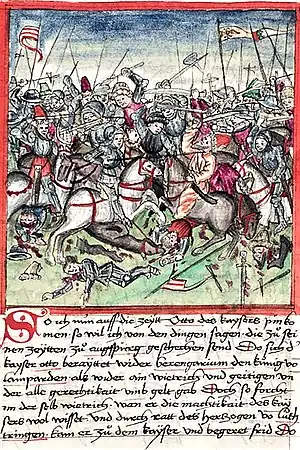955
Year 955 (CMLV) was a common year starting on Monday (link will display the full calendar) of the Julian calendar.
| Millennium: | 1st millennium |
|---|---|
| Centuries: | |
| Decades: | |
| Years: |
| 955 by topic |
|---|
| Leaders |
|
| Categories |
|
| Gregorian calendar | 955 CMLV |
| Ab urbe condita | 1708 |
| Armenian calendar | 404 ԹՎ ՆԴ |
| Assyrian calendar | 5705 |
| Balinese saka calendar | 876–877 |
| Bengali calendar | 362 |
| Berber calendar | 1905 |
| Buddhist calendar | 1499 |
| Burmese calendar | 317 |
| Byzantine calendar | 6463–6464 |
| Chinese calendar | 甲寅年 (Wood Tiger) 3651 or 3591 — to — 乙卯年 (Wood Rabbit) 3652 or 3592 |
| Coptic calendar | 671–672 |
| Discordian calendar | 2121 |
| Ethiopian calendar | 947–948 |
| Hebrew calendar | 4715–4716 |
| Hindu calendars | |
| - Vikram Samvat | 1011–1012 |
| - Shaka Samvat | 876–877 |
| - Kali Yuga | 4055–4056 |
| Holocene calendar | 10955 |
| Iranian calendar | 333–334 |
| Islamic calendar | 343–344 |
| Japanese calendar | Tenryaku 9 (天暦9年) |
| Javanese calendar | 855–856 |
| Julian calendar | 955 CMLV |
| Korean calendar | 3288 |
| Minguo calendar | 957 before ROC 民前957年 |
| Nanakshahi calendar | −513 |
| Seleucid era | 1266/1267 AG |
| Thai solar calendar | 1497–1498 |
| Tibetan calendar | 阳木虎年 (male Wood-Tiger) 1081 or 700 or −72 — to — 阴木兔年 (female Wood-Rabbit) 1082 or 701 or −71 |

Battle of Lechfeld on an illustration of 1457.
Events
Europe
- August 10 – Battle of Lechfeld: King Otto I ("the Great") defeats the Hungarians (also known as Magyars) near Augsburg (Germany). Otto's army (7,000 men), mainly composed of heavy cavalry, overwhelms the Hungarians along the Lech River. The German losses are heavy, among them Conrad ("the Red") and many other nobles. The commanders of the Hungarian army, Bulcsú and Lehel, are captured and executed. This victory puts an end to the Hungarian campaigns into western Europe.[1]
- October 16 – Battle on the Raxa: Otto I, allied with the Rani tribe, defeats the Obotrite federation, led by Nako and his brother Stoigniew (probably at the Recknitz or Elde rivers) near Mecklenburg. The Elbe Slavs are forced to pay tribute, and accept a peace agreement.[2]
England
- November 23 – King Eadred (or Edred) dies childless after a 9-year reign at Frome (Somerset). He is succeeded by his 15-year-old nephew, Eadwig, as King of England.
Africa
- The Kharijite Banu Ya'la tribe revolts against the Fatimid Caliphate in Ifriqiya and destroys the city of Oran (modern Algeria). They construct a new capital, Ifgan, near Mascara.[3]
Religion
- November 8 – Pope Agapetus II dies after a 9-year reign. He is succeeded by John XII, the son of Alberic II (the late ruler of Rome), as the 130th pope of the Catholic Church.
Births
- May 10 – Al-Aziz Billah, caliph of the Fatimid Caliphate (d. 996)
- October 22 – Qian Weijun, king of Wuyue (Ten Kingdoms) (d. 991)
- November 9 – Gyeongjong of Goryeo, ruler of Korea (d. 981)
- Aboazar Lovesendes, Portuguese nobleman (approximate date)
- Ælfric of Eynsham, English abbot and writer (approximate date)
- Arduin of Ivrea (I), Lombard margrave and king of Italy (approximate date)
- Eido I (or Ägidius), German nobleman and bishop (d. 1015)
- Ezzo (or Ehrenfried), Count Palatine of Lotharingia (Germany) (approximate date)
- Gisela of Burgundy, duchess of Bavaria (approximate date)
- Gunther of Bohemia, German hermit and saint (d. 1045)
- Lutgardis of Luxemburg, countess of Holland (Netherlands)
- Matilda, Abbess of Quedlinburg, German princess-abbess and daughter of Otto I (d. 999)
- Otto II, Holy Roman Emperor ("the Red") (d. 983)
- Theophanu, empress consort of the Holy Roman Empire (d. 991)
- Kunhsaw Kyaunghpyu, king of the Pagan dynasty (d. 1048)
Deaths
- July 23 – He Ning, Chinese official and chancellor (b. 898)
- August 10
- Bulcsú, Hungarian tribal chieftain (horka)
- Conrad ("the Red"), duke of Lorraine
- October 16 – Stoigniew, Obotrite prince and co-ruler
- November 1 – Henry I, Duke of Bavaria
- November 8 – Pope Agapetus II, Catholic Church pontiff (b. 905)
- November 23 – Eadred (or Edred), king of England (b. 923)
- Abu 'Ali Chaghani, ruler of Chaghaniyan (Turkmenistan)
- Bermudo Núñez, count of Cea (Spain) (approximate date)
- Gamle Eirikssen, Norwegian Viking ruler (b. 910)
- Hervé I, count of Mortagne and Perche
- Lehel, Hungarian tribal chieftain (horka)
- Muhammad ibn Shaddad, Shaddadid ruler
- Parantaka I, ruler of Chola Kingdom (India)
- Sultan Satuq Bughra Khan, Kara-Khanid ruler
References
- Bóna, István (2000). The Hungarians and Europe in the 9th-10th centuries. Budapest: Historia - MTA Történettudományi Intézete, p. 54. ISBN 963-8312-67-X.
- Timothy Reuter (1999). The New Cambridge Medieval History, Volume III, p. 248. ISBN 978-0-521-36447-8.
- Gilbert Meynier (2010). L'Algérie cœur du Maghreb classique. De l'ouverture islamo-arabe au repli (658-1518). Paris: La Découverte; p.28.
This article is issued from Wikipedia. The text is licensed under Creative Commons - Attribution - Sharealike. Additional terms may apply for the media files.